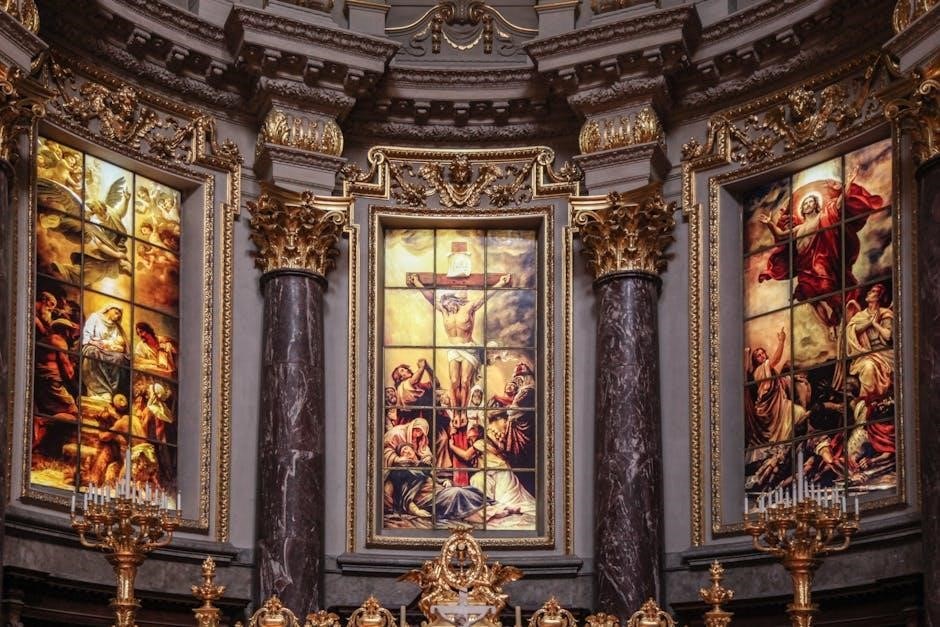Colors in the Bible are not arbitrary; they carry profound symbolism, reflecting cultural, spiritual, and theological contexts. They highlight divine attributes, human experiences, and eschatological themes, offering deeper insights into Scripture.
Importance of Color Symbolism in Scripture
Color symbolism in Scripture provides a richer understanding of God’s messages. Just as numbers and other symbols point to Jesus, colors do the same, revealing His person and works. This symbolism is part of Hebrew hermeneutics, aiding in interpreting prophecy and apocalyptic literature like Daniel and Revelation. Understanding colors enhances our appreciation for how God communicates truths. It adds depth, showing divine attributes, human experiences, and eschatological themes. Scripture often implies meanings, like green for flourishing, derived from nature. Colors remind us of God’s plan, just as rainbows remind us of His covenant.

Primary Colors and Their Significance
The primary colors, including red, blue and yellow, hold particular significance in the Bible. Each color offers unique insight into understanding biblical concepts and God’s communication through Scripture.
Red: Blood, Sacrifice, and Humanity
Red, often seen as the color of blood, represents sacrifice, passion, and love. In the Old Testament, ‘oudem’ means red clay, linking it to mankind, like Adam. The symbolism extends to humanity, passion, and the heart, often depicted in brilliant red, symbolizing love.
In the New Testament, red signifies Jesus’ sacrifice, representing redemption. Isaiah 1:18 uses red (scarlet/crimson) to illustrate sin, contrasting it with the purity of white. Red’s association with blood highlights life, death, and the transformative power of sacrifice in biblical narratives.
Furthermore, red embodies intense emotions, both positive and negative. It reflects love, but also anger and war. This duality makes red a powerful reminder of humanity’s complex nature and the profound impact of sacrifice.
Blue: Divinity, Heaven, and the Word of God
Blue, a primary color, spiritually signifies divinity, heaven, and the Word of God. It represents the healing power of God and is biblically associated with the most sublime subjects. Numbers 15:38-41 denotes this meaning, referencing a ribband of blue on the fringe of borders.
Blue points to heaven, where God dwells, symbolizing His holiness and grace. The association with the sky reinforces its connection to the divine realm. Blue often represents loyalty, trust, and wisdom, qualities associated with God’s character.
Throughout Scripture, blue is used in various contexts to evoke a sense of reverence and spiritual significance. Its presence in the tabernacle and priestly garments underscores its importance in religious practices, symbolizing God’s presence and the purity of His Word.
Yellow/Gold: Glory of God, Faith, and Joy
Yellow and gold symbolize the glory of God, faith, and joy. These colors evoke a sense of divine presence and spiritual enlightenment. Gold, in particular, represents royalty, divinity, and the preciousness of God’s nature. It reflects the splendor and majesty of the heavens.
Yellow and gold are also the color of fire, representing the presence of God and His refining process. Fire symbolizes purification, passion, and transformative power. The sun, golden yellow, represents God’s life-giving energy and radiant light.
In Scripture, yellow and gold are associated with wisdom, understanding, and divine favor. They remind us of the joy and blessings that come from trusting in God. These colors inspire faith, encourage praise, and signify the enduring glory of God.
Secondary Colors and Biblical Meanings
Secondary colors in the Bible, like green, purple, and orange, carry significant spiritual meanings. They symbolize concepts such as new life, royalty, and divine fire, enriching our understanding of scripture.
Green: Immortality and New Life
Green, a secondary color formed by mixing yellow (trials) with blue (the Word of God), symbolizes immortality and new life in the Bible. This color is often associated with flourishing, vigor, and prosperity, representing spiritual growth and renewal. Just as vibrant green signifies life in springtime, it mirrors the concept of eternal life promised through faith.
The enduring nature of evergreen plants further emphasizes this theme, suggesting a life that doesn’t wither (Psalm 1:3). Green in Scripture serves as a potent visual reminder of God’s promise of everlasting life and the continuous cycle of rebirth and revitalization.
Green is often used as a symbol of life and vigor, symbolizing Gods Person and work. Through understanding symbolism, it will give us a deeper and greater understanding of the Bible.
Purple: Royalty and Kingship
Purple, a color historically associated with royalty and wealth, maintains this significance in the Bible, symbolizing kingship and authority. Derived from rare and expensive dyes, purple garments were worn by kings and emperors, signifying their elevated status and power. In Scripture, purple is often linked to figures of authority and those in positions of leadership, underscoring their regal status.
The use of purple in the tabernacle and priestly garments further emphasizes its association with divine authority and the sacredness of kingship. By this we can understand symbolism giving us a greater understanding of the bible. Purple points to One who would come as Messiah, the King of the Jews.
Orange: Fire of God and Deliverance
Orange, a vibrant and dynamic color, symbolizes the fire of God and deliverance in biblical contexts, representing passionate praise. As a combination of red and yellow, orange embodies the fervor of red and the glory of yellow, signifying a powerful and transformative force. The fire of God is often associated with purification, judgment, and the presence of the Divine, making orange a color of intense spiritual significance.
Deliverance, closely linked to the fire of God, speaks of liberation and rescue from oppression or danger. Orange signifies a fiery zeal and a fervent spirit, inspiring believers to express their gratitude and devotion through passionate praise and worship.

Other Colors and Their Interpretations
Beyond primary and secondary hues, other colors hold symbolic weight. These nuanced interpretations provide a richer understanding of biblical texts. Each color adds depth to the narrative and messages.
White: Righteousness and Purity
White, consistently symbolizes righteousness and purity. It is associated with holiness and divine light. In Revelation, the saints are often depicted wearing white robes, signifying their cleansed state through Christ’s sacrifice. White represents new beginnings, cleansing, and spiritual transformation.
The color highlights the transformative power of faith and the aspiration for moral excellence. Garments washed and made white symbolize spiritual renewal and freedom from sin. This color underscores the importance of moral integrity and spiritual cleanliness.
White is often linked to the presence of God, emphasizing divine holiness. It reflects a state of innocence and a desire to reflect God’s character. Through its association with purity and righteousness, white calls believers to strive for spiritual perfection.
Black: Darkness, Sin, and Mourning
Black in the Bible represents darkness, sin, and mourning. It symbolizes spiritual emptiness, absence of light, and moral decay. Black is used to depict the consequences of sin and separation from God.
The color underscores the dire state of humanity without divine intervention. Black signifies a lack of understanding, spiritual blindness, and the presence of evil. It is associated with grief, sorrow, and the pain of loss.
References to black highlight the need for repentance and redemption. The color serves as a stark reminder of the spiritual condition before salvation. Black depicts a world devoid of hope and filled with despair. Through its association with sin and mourning, black encourages reflection and a yearning for spiritual light.
Scarlet: Royalty and Fine Linen
Scarlet in the Bible symbolizes royalty and fine linen, representing opulence, power, and high status. It is associated with the tabernacle, signifying divine presence and sacredness. Scarlet denotes wealth, nobility, and the luxurious garments worn by kings and priests.
The color highlights the splendor of God’s dwelling place and the refined materials used in worship. Scarlet signifies honor, dignity, and the esteemed position of those in authority. It is used to depict the exquisite fabrics that adorned the tabernacle and its furnishings.
References to scarlet emphasize the importance of reverence and respect. The color serves as a reminder of God’s majesty and the sacredness of His sanctuary. Scarlet denotes a world of refinement, luxury, and spiritual significance, linking earthly grandeur to divine purpose.
The rainbow, with its array of colors, symbolizes God’s covenant with humanity, promising never to destroy the earth again by flood. It represents hope, reconciliation, and God’s unwavering faithfulness to His word.

Rainbow Colors and the Covenant
The Rainbow as a Symbol of God’s Promise
The rainbow stands as a stunning natural phenomenon and a powerful symbol of God’s covenant with humanity after the great flood. Composed of red, orange, yellow, green, blue, indigo, and violet, each color contributes to its profound significance. The rainbow reminds us of God’s promise never again to destroy the earth with a flood, signifying hope, renewal, and divine faithfulness.
This vibrant arc serves as a visual testament to God’s mercy and commitment to His creation. It reassures us of His unwavering love and protection, offering solace and encouragement in times of uncertainty. The rainbow’s presence in the sky is a constant reminder of God’s enduring promise and His eternal covenant with all living beings. It is a symbol of peace, reconciliation, and the enduring bond between God and humanity, a vibrant display of His grace and faithfulness.
Understanding color symbolism enriches Bible study, offering deeper insights into scripture. Recognizing the meanings behind colors enhances interpretation, revealing hidden layers of spiritual significance and connecting us to God’s message.

Application and Study
Using Color Symbolism in Bible Study and Interpretation
Incorporating color symbolism into Bible study enhances comprehension of scriptural narratives and theological concepts. Recognizing that colors in the Bible often convey deeper meanings beyond their visual appearance can unlock new layers of understanding. For instance, the vibrant red symbolizing bloodshed and sacrifice can bring a richer interpretation to passages about redemption. Similarly, the calming blue representing divinity and heavenly grace can deepen one’s appreciation of God’s holiness.
By paying attention to the colors used in biblical texts, we gain a more profound grasp of the spiritual messages being conveyed. This approach helps us appreciate how colors serve to highlight divine attributes, human experiences, and eschatological themes. Studying color symbolism can transform Bible study into a more immersive and enlightening experience, fostering a deeper connection to the text and its timeless truths.
Deeper Understanding Through Color
Exploring the biblical significance of colors enriches our understanding of Scripture, revealing layers of meaning often overlooked. Each hue, from the red of redemption to the blue of divinity, carries profound spiritual weight. Recognizing these symbolic associations allows us to connect more deeply with the divine messages embedded in the text.
By appreciating how colors highlight divine attributes, human experiences, and eschatological themes, we gain a more nuanced perspective on biblical narratives. This deeper engagement fosters a richer, more personal relationship with the Word, transforming our study into a vibrant and insightful journey. Embracing color symbolism unlocks a new dimension of spiritual understanding, illuminating the timeless truths of the Bible in fresh and meaningful ways.
